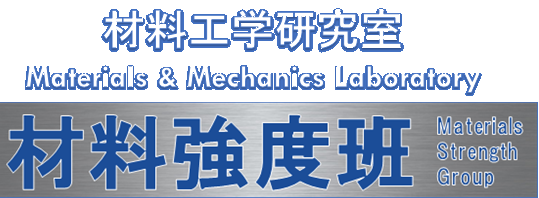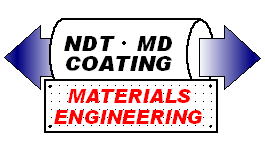
◆Fatigue fracture problem
The stress-life (S-N) diagrams of non-ferrous alloys do not usually exhibit
distinct knee-points (fatigue limit or endurance limit) unlike those of
carbon steels. Such a character necessitates us to use a fatigue strength
at finite cycles (e.g. 10^7cycle stress) instead of a cycle-independent threshold stress value. Here
we raise a question: can we change such an inconvenient character of conventional
alloys through a simple metallurgical modification?
We then focused on the possible relation between fatigue limit and strain-aging
in carbon steels suggested many decades ago. We employed a conventional
A6061-T6 (a typical precipitation-hardened Al alloy) as a base metal and
added small amount of strain-aging inducer, i.e. magnesium (Mg). What we
encountered was a distinct fatigue limit and, moreover, a clear coaxing
effect!
For more detail, see:
Y. Takahashi, T. Shikama, R. Nakamichi, Y. Kawata, N. Kasagi, H. Nishioka,
S. Kita, M. Takuma, H. Noguchi, Effect of additional magnesium on mechanical
and high-cycle fatigue properties of 6061-T6 alloy, Materials Science &
Engineering A641, 2015, pp. 263–273 (http://dx.doi.org/10.1016/j.msea.2015.06.051)
Related studies:
T. Shikama, Y. Takahashi, L. Zeng, S. Yoshihara, T. Aiura, K. Higashida,
H. Noguchi, Distinct fatigue crack propagation limit of new precipitation-hardened
aluminium alloy, Scripta Materialia, Vol. 67, 2012, pp. 49–52 (https://doi.org/10.1016/j.scriptamat.2012.03.018)
Y. Takahashi, T. Shikama, S. Yoshihara, T. Aiura, H. Noguchi, Study on
dominant mechanism of high-cycle fatigue life in 6061-T6 aluminum alloy
through micro-analyses of microstructurally small cracks, Acta Materialia,
Vol. 60, 2012, pp. 2554-2567 (https://doi.org/10.1016/j.actamat.2012.01.023)
Y. Takahashi, H. Yoshitake, R. Nakamichi, T. Wada, M. Takuma, T. Shikama,
H. Noguchi, Fatigue limit investigation of 6061-T6 aluminium alloy in giga-cycle
regime, Materials Science & Engineering A, Vol. 614, 2014, pp. 243-249.
(https://doi.org/10.1016/j.msea.2014.07.039)
◆ Creep fracture problem
Structural components like butt joints and LSI packages contain metal/polymer
interfaces. Polymers, unlike metals having high melting temperature, are
subjected to time-dependent plasticity (creep) even at room temperature.
The fracture nucleation from a free-edge, where the interface meets a free
surface, is quantified by the fracture mechanics concept for time-independent
problems. The validity of the concept for time-dependent case, however,
remains unknown.
We pulled Epoxy/SUS butt joints under various sustained loads and found
a clear stress-life (S-T) tendency regarding fracture nucleation. Near-edge
stress analysis by the FEM revealed that the event was controlled by a
unique relation of two time-dependent parameters (K; stress intensity factor,
l: stress singularity). This marks the first example demonstrating the
validity of the so-called “K-l criterion” in the time domain.
For more detail, see:
Y. Takahashi, K. Inoue, M. Takuma, K. Saitoh, T. Sato, Fracture mechanics
criterion of time-dependent crack initiation from interface free-edge in
adhesively bonded butt joints, Engineering Fracture Mechanics, Vol. 186,
2017, pp. 368–377 (http://dx.doi.org/10.1016/j.engfracmech.2017.08.017)
Related studies:
H. Hirakata, T. Hirako, Y. Takahashi, Y. Matsuoka, T. Kitamura, Creep crack
initiation at a free edge of an interface between submicron thick elements,
Engineering Fracture Mechanics, Vol. 75, 2008, pp. 2907–2920 (https://doi.org/10.1016/j.engfracmech.2008.01.007)








